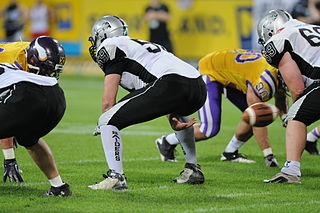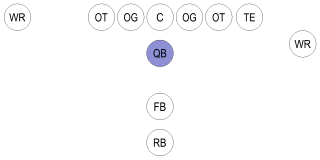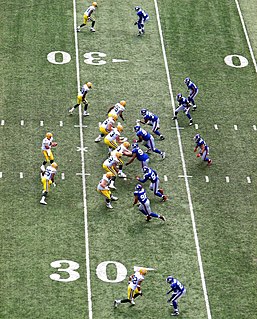Related Research Articles

A snap is the backward passing of the ball in gridiron football at the start of play from scrimmage.

The quarterback, colloquially known as the "signal caller", is a position in gridiron football. Quarterbacks are members of the offensive platoon and mostly line up directly behind the offensive line. In modern American football, the quarterback is usually considered the leader of the offense, and is often responsible for calling the play in the huddle. The quarterback also touches the ball on almost every offensive play, and is the offensive player that almost always throws forward passes. When the QB is tackled behind the line of scrimmage, it is called a sack.

The shotgun formation is a formation used by the offensive team in gridiron football mainly for passing plays, although some teams use it as their base formation. Instead of the quarterback receiving the snap from center at the line of scrimmage, in the shotgun he stands farther back, often five to seven yards off the line. Sometimes the quarterback will have a back on one or both sides before the snap, while other times he will be the lone player in the backfield with everyone spread out as receivers.

A wide receiver (WR), also referred to as a wideout, historically known as a split end (SE), is an eligible receiver in gridiron football. A key skill position of the offense, WR gets its name from the player being split out "wide", farthest away from the rest of the offensive formation.
The hurry-up offense is an American football offensive style, which has two different but related forms in which the offensive team avoids delays between plays. The hurry-up, no-huddle offense (HUNH) refers to avoiding or shortening the huddle to limit or disrupt defensive strategies and flexibility. The two-minute drill is a clock-management strategy that may limit huddles but also emphasizes plays that stop the game clock. While the two-minute drill refers to parts of the game with little time remaining on the game clock, the no-huddle may be used in some form at any time. The no-huddle offense was pioneered by the Cincinnati Bengals and reached its most famous and complete usage by the Buffalo Bills, nicknamed the "K-Gun", during the 1990s under head coach Marv Levy and offensive coordinator Ted Marchibroda.
The Statue of Liberty is a trick play in American football named after the Statue of Liberty.
Strategy forms a major part of American football. Both teams plan many aspects of their plays (offense) and response to plays (defense), such as what formations they take, who they put on the field, and the roles and instructions each player are given. Throughout a game, each team adapts to the other's apparent strengths and weaknesses, trying various approaches to outmaneuver or overpower their opponent in order to win the game.

Center (C) is a position in gridiron football. The center is the innermost lineman of the offensive line on a football team's offense. The center is also the player who passes the ball between his legs to the quarterback at the start of each play.
In American football, the fumblerooski is a trick play in which the football is intentionally and stealthily placed on the ground (fumbled) by an offensive player, usually the quarterback. The offensive team then attempts to distract and confuse the defense by pretending that a ball carrier is running in one direction while another offensive player retrieves the ball from the turf and runs in a different direction, hoping to gain significant yardage before the defense realizes which player is actually carrying the football.
A trick play, also known as a gadget play, gimmick play or trickeration, is a play in gridiron football that uses deception and unorthodox tactics to fool the opposing team. A trick play is often risky, offering the potential for a large gain or a touchdown if it is successful, but with the chance of a significant loss of yards or a turnover if not. Trick plays are rarely used not only because of the riskiness, but also to maintain the element of surprise for when they are used.

In American football and Canadian football, a quarterback kneel, also called taking a knee, genuflect offense, kneel-down offense, or victory formation, occurs when the quarterback immediately kneels to the ground, ending the play on contact, after receiving the snap. It is primarily used to run the clock down, either at the end of the first half or the game itself, to preserve a lead. Although it generally results in a loss of a yard and uses up a down, it minimizes the risk of a fumble, which would give the other team a chance at recovering the ball.

In American football, the specific role that a player takes on the field is referred to as their "position". Under the modern rules of American football, both teams are allowed 11 players on the field at one time and have "unlimited free substitutions", meaning that they may change any number of players during any "dead ball" situation. This has resulted in the development of three task-specific "platoons" of players within any single team: the offense, the defense, and the so-called 'special teams'. Within these three separate "platoons", various positions exist depending on the jobs that the players are doing.
In American football, a play is a close-to-the-ground plan of action or strategy used to move the ball down the field. A play begins at either the snap from the center or at kickoff. Most commonly, plays occur at the snap during a down. These plays range from basic to very intricate. Football players keep a record of these plays in a playbook.

Zone coverage is a defense scheme in gridiron football used to protect against the pass.
The following terms are used in American football, both conventional and indoor. Some of these terms are also in use in Canadian football; for a list of terms unique to that code, see Glossary of Canadian football.
Wildcat formation describes a formation for the offense in football in which the ball is snapped not to the quarterback but directly to a player of another position lined up at the quarterback position. The Wildcat features an unbalanced offensive line and looks to the defense like a sweep behind zone blocking. A player moves across the formation prior to the snap. However, once this player crosses the position of the running back who will receive the snap, the play develops unlike the sweep.

Buck-lateral is an American football play or a series of plays used in the Single-wing formation. Since the Single-Wing formation lost prominence by 1950, the football play referred to as the Buck-lateral is almost gone from football's vocabulary. However, prior to this time, the buck-lateral play gave fullbacks the option to run, lateral, or hand off the ball to another player. Running the buck-lateral required an offensive scheme that needed the fullback to possess many specialized skills, as opposed to today's fullback who mainly blocks and carries the ball infrequently.
A play calling system in American football is the specific language and methods used to call offensive plays.

The Colts Catastrophe was an unsuccessful National Football League (NFL) trick play attempted by the Indianapolis Colts against the New England Patriots on October 18, 2015. It occurred near the end of the third quarter in the teams' Week 6 game of the 2015 NFL season.